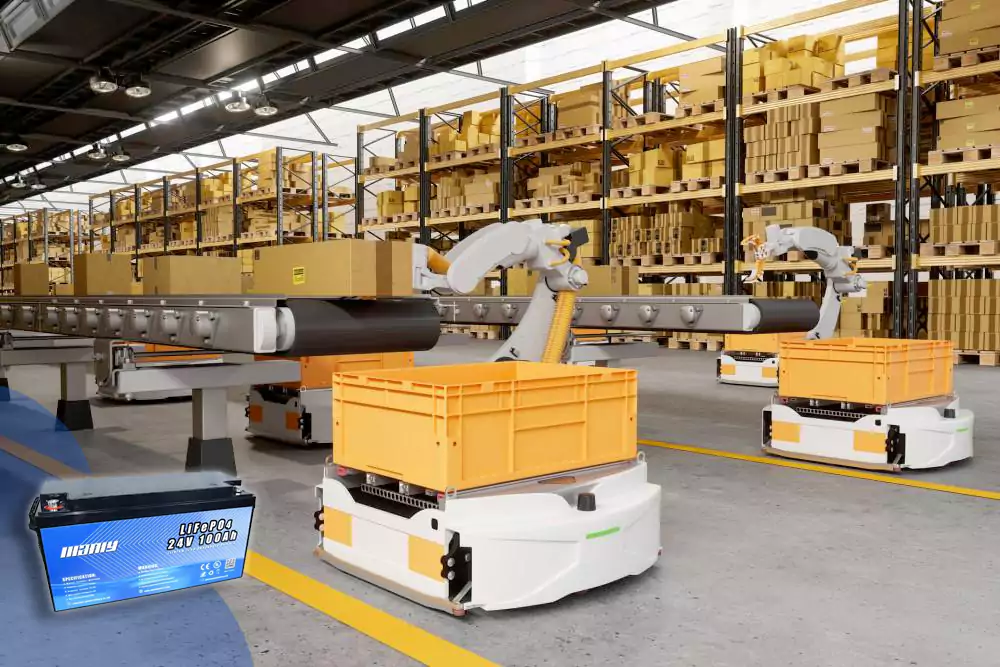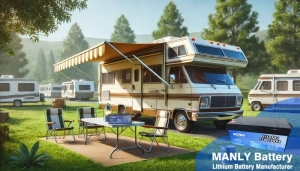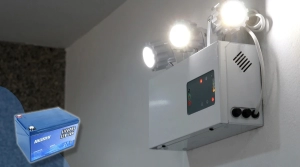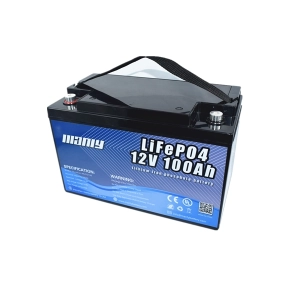Top 10 Autonomous Mobile Robots in 2024: A Comprehensive Guide
Table of Contents
- Top 10 Autonomous Mobile Robots in 2024: A Comprehensive Guide
- Introduction to Autonomous Mobile Robots
- Advantages of Autonomous Mobile Robots
- Leading Companies in the Autonomous Mobile Robots Industry
- Best 10 Autonomous Mobile Robots of 2024
- Optimal Battery Solutions for Autonomous Mobile Robots
- Top Battery Suppliers for Autonomous Mobile Robots in 2024
- Conclusion
- Learn More About Battery

Introduction to Autonomous Mobile Robots
Autonomous Mobile Robots (AMRs), a groundbreaking class of robotics, are ingeniously designed to independently interact with their environments, often functioning for prolonged periods without human interference. This autonomy is a leap forward from the traditional concept of robots, which people often associate with stationary machines in factories or those requiring direct human control.The core of an autonomous robot's definition lies in its ability to independently perform tasks and navigate spaces. Unlike their predecessors, these robots are not limited to a single location or dependent on human guidance for movement. This independence is primarily due to their sophisticated sensory systems, which allow them to perceive their surroundings, identify obstacles, and adapt to varying environmental conditions.A quintessential example of an autonomous robot is the robotic vacuum cleaner, like the popular Roomba. These devices, equipped with an array of sensors, can map out spaces, track movements, and avoid obstacles such as stairs or furniture, operating efficiently with minimal human input.In the realm of technology, autonomous robots stand out for their advanced capabilities in automating maintenance and operational tasks that were traditionally handled by humans. Their functionality is encapsulated in three fundamental processes: perception, decision-making, and actuation. These processes enable them to gather information from their environment, make informed decisions, and execute actions autonomously.Moreover, AMRs are not just confined to household tasks. They have diverse applications ranging from medical delivery in hospitals to complex navigation in multi-storied buildings, showcasing their versatility and the significant advancement in robotic technology. Their ability to operate independently, coupled with the need for occasional human interaction for specific tasks or maintenance, underscores the balance between autonomy and human oversight in modern robotics.In conclusion, the evolution of autonomous mobile robots marks a significant milestone in the field of robotics, offering a blend of independence, intelligence, and adaptability that paves the way for innovative applications across various sectors.Advantages of Autonomous Mobile Robots
Autonomous Mobile Robots (AMRs) are transforming the way tasks are performed across various industries, offering a multitude of benefits that enhance efficiency, safety, and cost-effectiveness. Here are some key advantages of integrating AMRs into operations:- Ease of Installation and Modification
- AMRs, leveraging advanced navigation technologies like ANT, are remarkably easy to install and require minimal changes to existing infrastructure. This means they can be quickly deployed with little disruption to ongoing operations.
- Unlike traditional Automated Guided Vehicles (AGVs) that may need extensive setup like floor lines or laser targets, AMRs typically need only minimal markers, if any, making route modifications and updates swift and effortless.
- Enhanced Safety
- AMRs operate with a high degree of safety, adhering to strict standards such as EN 1525 and ANSI 56.5:2012. Their consistent speed and controlled movements, combined with advanced safety systems, significantly reduce the risk of accidents.
- Their ability to detect obstacles and autonomously find alternative routes ('obstacle avoidance') adds an additional layer of safety. Furthermore, their consistent operation eliminates the risk of fatigue-induced errors common in human-operated vehicles.
- Reliable and Consistent Performance
- The reliability of AMRs in executing programmed tasks is unmatched. Their ability to consistently perform assigned tasks without deviations ensures minimal damage to stock and materials, leading to higher operational efficiency.
- AMRs do not suffer from human limitations such as fatigue, sick leaves, or turnovers, ensuring uninterrupted operation.
- Effective Collaborative Operation (Cobots)
- AMRs excel as cobots (collaborative robots), working alongside human workers without being perceived as intimidating or a threat to jobs, especially in performing routine or unskilled tasks.
- Their integration into workflows is often seamless, complementing human efforts and enhancing overall productivity.
- Liberating Human Workers for Higher-Value Tasks
- By automating mundane tasks like transporting goods, AMRs free human staff to focus on activities that require human skills and intelligence, such as problem-solving and customer interaction.
- This not only optimizes the use of human resources but also increases job satisfaction by eliminating monotonous tasks.
- Cost Optimization and Staffing Efficiency
- AMRs can significantly reduce the need for manual labor in repetitive transportation tasks, potentially leading to a leaner workforce and lower labor costs.
- The predictable maintenance and operational costs of AMRs provide a stable financial model compared to the fluctuating costs associated with human labor.
- Environmental Friendliness
- Most AMRs are battery-powered and produce lower emissions compared to traditional manual vehicles, making them suitable for environmentally sensitive settings like cleanrooms.
- The reduction in indirect emissions, such as those from commuting or facility HVAC adjustments, further enhances their green credentials.
- Scalability
- The scalability of AMRs is a key advantage, allowing businesses to easily expand or modify their robotic fleet based on operational needs.
- This flexibility ensures that businesses can adapt quickly to changing demands or operational scales, whether scaling up or down.
- Facilitating 24/7 Operations
- AMRs are capable of continuous operation, only pausing for battery recharges, enabling businesses to move towards round-the-clock manufacturing or logistics operations.
- This extended operational capability can significantly boost productivity and help meet growing customer demands.
- Long-term Cost-Effectiveness
- Although the initial investment in AMR technology can be substantial, the long-term savings and efficiency gains often result in a favorable return on investment, usually within a couple of years.
- The predictable cost structure associated with AMRs aids in accurate budgeting and financial planning.
Leading Companies in the Autonomous Mobile Robots Industry
The Autonomous Mobile Robots (AMR) industry is flourishing with numerous innovative companies driving the evolution of robotics technology. Here, we explore some of the leading organizations that have made significant strides in this field.- Astro Technologies, Inc.
- Founded in 2021 and headquartered in Pasadena, California, Astro Technologies is at the forefront of developing AMR technology. Their flagship product, Arc, is an autonomous unloading robot, equipped with advanced sensors and AI-enabled picking capabilities.
- The company also offers Robofleet, an open-source robotics fleet management platform, and a customizable Robotics-as-a-Service (RaaS) program. Their products cater to diverse sectors, including SMBs, 3PL providers, and fulfillment centers.
- DAIHEN Corporation
- Established in 1919 in Osaka, Japan, DAIHEN Corporation is a versatile manufacturer, offering products ranging from power distribution equipment to robot welding sensors.
- Their extensive product line includes transformers, power distribution boards, and welding & cutting machines, showcasing their versatility in industrial applications.
- KAZE Robotics (a subsidiary of PBA Group)
- Founded in 2017 and based in Singapore, KAZE Robotics specializes in automated material handling solutions.
- They design innovative AMRs like deck lift rotators and smart roller conveyor robots, suitable for transporting bulky items in production areas and warehouses. Additionally, they offer autonomous lift trucks and manipulator AMRs that combine cobot dexterity with AMR mobility.
- KUKA AG
- With its roots dating back to 1898 in Augsburg, Germany, KUKA AG is a subsidiary of GD Midea Holding Co., Ltd. The company is renowned for its automation solutions across various industries including medical, automotive, and warehousing.
- KUKA’s offerings include robot systems, production machines, and specialized welding processes, complemented by repair and engineering services.
- Omron Corporation
- Originating in 1933 in Kyoto, Japan, Omron Corporation has been a pioneer in automation technology. They developed the first contactless proximity switch and have a diverse portfolio including industrial robots, electronic components, and healthcare devices.
- Omron's innovations like online cash machines and microsensing devices demonstrate their commitment to technological advancement.
- Yaskawa Europe GmbH
- A subsidiary of Japan's Yaskawa Electric Corporation, Yaskawa Europe was founded in 1915 and is headquartered in Hattersheim, Hesse.
- They are known for their industrial robots, AC drives, servo motors, and inverters, catering to industries like automotive, packaging, and metalworking. Their commitment to quality and environmental management is reflected in their ISO certifications.
- TinyMobileRobots ApS
- Based in Malling, Midtjylland, Denmark, and founded in 2015, TinyMobileRobots specializes in robots for field marking, road marking, and surveying.
- Their products are essential for sports line marking, construction, and land surveying, offering GPS-based precision and versatility.
- Amazon Robotics
- A crucial arm of Amazon’s e-commerce operations, Amazon Robotics has transformed warehousing and order fulfillment with its fleet of autonomous robots.
- These robots, working alongside human workers, enhance the efficiency and precision of the order fulfillment process, setting new benchmarks in the e-commerce industry.
- AGILOX Services GmbH
- AGILOX Services GmbH focuses on optimizing transportation in warehouse and production logistics with their AMRs.
- Utilizing X-SWARM technology, their robots exhibit real-time communication and intelligent order distribution. Their product range includes the Agilox One, Agilox OCF, and Agilox ODM, each designed for specific intralogistics requirements.
Best 10 Autonomous Mobile Robots of 2024
1. MiR (Mobile Industrial Robots) MiR100/MiR200
- The MiR100 and MiR200 models from Mobile Industrial Robots have established themselves as versatile and reliable AMRs in various sectors, including manufacturing, logistics, and healthcare.
- These robots stand out for their user-friendly programming interface and advanced navigation capabilities, allowing them to efficiently maneuver through complex environments. Their adaptability and ease of integration make them ideal for material handling and internal transportation tasks.

2. Locus Robotics LocusBot
- Locus Robotics' LocusBot is specifically designed to revolutionize warehouse operations. These AMRs work collaboratively with human workers, significantly enhancing picking efficiency and reducing manual walking time in distribution centers.
- Known for their intuitive operation and seamless integration with warehouse management systems, LocusBots are instrumental in optimizing fulfillment processes, thereby improving overall productivity in logistics environments.
3. Omron LD Series
- The Omron LD Series represents a significant advancement in the AMR market, known for its adaptability across various environments. These robots are particularly notable for their advanced navigation and comprehensive safety features, making them a top choice for material transport in diverse settings.
- Their ability to interact safely in human-centric environments and their ease of integration into existing workflows make them a valuable asset in industries ranging from manufacturing to healthcare.
4. Fetch Robotics Freight500/Freight1500
- Fetch Robotics offers the Freight500 and Freight1500, designed for heavy-duty tasks within warehouse and logistics operations. These AMRs are capable of handling substantial payloads, making them ideal for moving large and heavy items efficiently.
- What sets these robots apart is their high degree of integration with warehouse management systems, enabling a streamlined approach to inventory and logistics management. Their robust design and advanced technology cater to the needs of modern warehouse environments.
5. Boston Dynamics Stretch
- Boston Dynamics' Stretch robot is specifically engineered for warehouse operations, focusing on tasks such as box handling. This AMR is distinguished by its advanced computer vision and manipulation capabilities, enabling precise and efficient handling of a variety of packages and goods.
- Stretch's versatility and adaptability make it an invaluable tool in modern warehouses, particularly in environments where speed and accuracy in sorting and moving items are crucial.
6. Seegrid Palion Pallet Truck
- The Seegrid Palion Pallet Truck is a standout in the realm of material handling, especially in manufacturing and distribution sectors. This AMR is known for its high payload capacity and its ability to navigate safely and efficiently in complex and dynamic environments.
- What makes the Palion Pallet Truck unique is its emphasis on safety and reliability, ensuring seamless integration into existing workflows while enhancing productivity and reducing the risk of workplace accidents.
7. Clearpath Robotics OTTO
- The OTTO series by Clearpath Robotics is renowned for its heavy-load material transport capabilities within industrial environments. These AMRs are celebrated for their robust design and seamless integration into existing workflows, making them ideal for complex and demanding tasks.
- Their versatility and ease of navigation in dynamic surroundings, combined with a user-friendly interface, position them as a top choice for businesses seeking to enhance their material handling and logistics processes.
8. Aethon TUG
- Aethon's TUG robot is a key player in the healthcare sector, known for its proficiency in transporting medications, linens, and meals within hospital settings. Its ability to navigate crowded and intricate corridors safely and efficiently makes it an indispensable asset in medical environments.
- The TUG robot is not just a transporter; it represents a shift towards more intelligent and responsive healthcare logistics, ensuring essential supplies are delivered reliably and autonomously.
9. KUKA KMR iiwa
- The KUKA KMR iiwa is a remarkable fusion of an autonomous mobile platform and a collaborative robot arm. This combination allows for a high degree of flexibility and precision in manufacturing and production environments.
- Known for its sophisticated sensor technology and intuitive programming, the KMR iiwa excels in tasks that require both mobility and delicate manipulation, making it a versatile solution for a variety of industrial applications.
10. Swisslog CarryPick
- Swisslog's CarryPick system is a specialized AMR solution designed for automated warehouse systems, particularly effective in small parts picking. Its modular and scalable nature allows it to adapt to various warehouse sizes and configurations.
- What sets CarryPick apart is its ability to streamline and automate the picking process, significantly enhancing efficiency and accuracy in inventory management. This system represents a significant advancement in warehouse automation technology.
Optimal Battery Solutions for Autonomous Mobile Robots
In the rapidly evolving world of Autonomous Mobile Robots (AMRs), selecting the right battery solution is crucial for maximizing efficiency and operational longevity. Here we explore the optimal battery choices for AMRs, focusing on the merits of lithium-ion and LiFePO4 batteries.- Lithium-Ion Batteries
- Lithium-ion batteries are a popular choice for AMRs due to their high energy density, which means they can store more energy per unit of weight compared to other types of batteries. This is particularly beneficial for AMRs as it translates into longer operation times between charges.
- Another advantage is their relatively quick charging time, enabling faster turnaround for AMRs in continuous operation settings. This aspect is crucial in environments where downtime can affect overall productivity.
- However, it’s important to note that lithium-ion batteries require sophisticated management systems to ensure safety and longevity, as they are sensitive to overcharging and temperature extremes.
- LiFePO4 (Lithium Iron Phosphate) Batteries
- LiFePO4 batteries are gaining popularity in AMR applications due to their safety and stability. These batteries are less prone to overheating and are more stable under high-temperature conditions, making them a safer option for robots operating in varying environmental conditions.
- They also offer a longer lifespan compared to traditional lithium-ion batteries. This longevity reduces the need for frequent replacements, thereby decreasing the long-term operational costs of AMRs.
- Although LiFePO4 batteries have a lower energy density compared to lithium-ion, their safety profile and durability make them a viable option, especially in applications where battery stability and longevity are paramount.
Top Battery Suppliers for Autonomous Mobile Robots in 2024
In 2024, the landscape of battery suppliers for Autonomous Mobile Robots (AMRs) is characterized by companies specializing in advanced lithium-ion and LiFePO4 lithium batteries. Here we highlight some of the leading manufacturers that are at the forefront of providing power solutions for AMRs:- CATL (Contemporary Amperex Technology Co. Limited)
- CATL is a global leader in the production of lithium-ion batteries, renowned for their high energy density and efficiency. Known for their cutting-edge technology and innovation in battery solutions, CATL’s batteries are a popular choice for AMRs due to their long life and reliability.
- LG Chem
- LG Chem, part of the larger LG Corporation, is another key player in the AMR battery market. They offer a range of lithium-ion batteries known for their durability and performance. LG Chem's commitment to research and development in battery technology makes their products well-suited for the demanding requirements of AMRs.
- Panasonic
- Panasonic is a household name that extends its expertise to the realm of lithium-ion batteries. Their batteries are favored for their balance of energy density and safety, making them a suitable choice for various types of AMRs, particularly in environments where safety and consistency are paramount.
- BYD (Build Your Dreams)
- BYD is not just an automobile manufacturer but also a significant contributor to the battery market. They specialize in lithium-ion and LiFePO4 batteries, known for their stability and eco-friendliness. BYD’s batteries are increasingly being adopted in AMRs, especially in applications that prioritize environmental sustainability.
- Samsung SDI
- Samsung SDI, a subsidiary of Samsung, is a major supplier of lithium-ion batteries. Their products are characterized by high energy efficiency and a long lifespan. Samsung SDI's continuous innovation in battery technology makes them a preferred choice for AMRs requiring robust and reliable power sources.
- Tesla
- While primarily known for electric vehicles, Tesla also produces high-quality lithium-ion batteries. Their batteries are renowned for their high energy capacity and longevity, making them a compelling option for AMRs, particularly in high-demand operational scenarios.
- MANLY Battery
- As a leading Chinese battery manufacturer with over 13 years of experience, MANLY Battery offers a vast range of LiFePO4 and lithium-ion batteries, from 6V to 72V.
- Their production capacity is impressive, with a daily output of 6MWh and over 3,000 batteries assembled daily. MANLY's batteries are suitable for a wide range of applications, including solar energy storage, industrial robots, and UPS systems.
- They provide customized battery solutions tailored to individual needs, ensuring each product meets specific client requirements. With global certifications like UN38.3, IEC62133, UL, and CE, MANLY batteries are a testament to quality and safety.
- Their LiFePO4 lithium battery is notable for their resilience, performing optimally in extreme temperatures and offering an energy efficiency rate of 95%. Added features like Bluetooth connectivity and intuitive battery level displays enhance the user experience.
- MANLY Battery's commitment to safety, functionality, and performance, backed by a 10-year warranty, makes them a preferred choice for AMR applications.




















